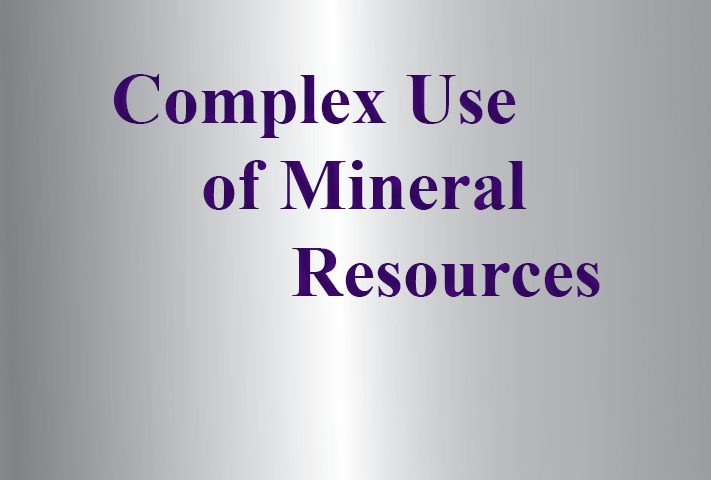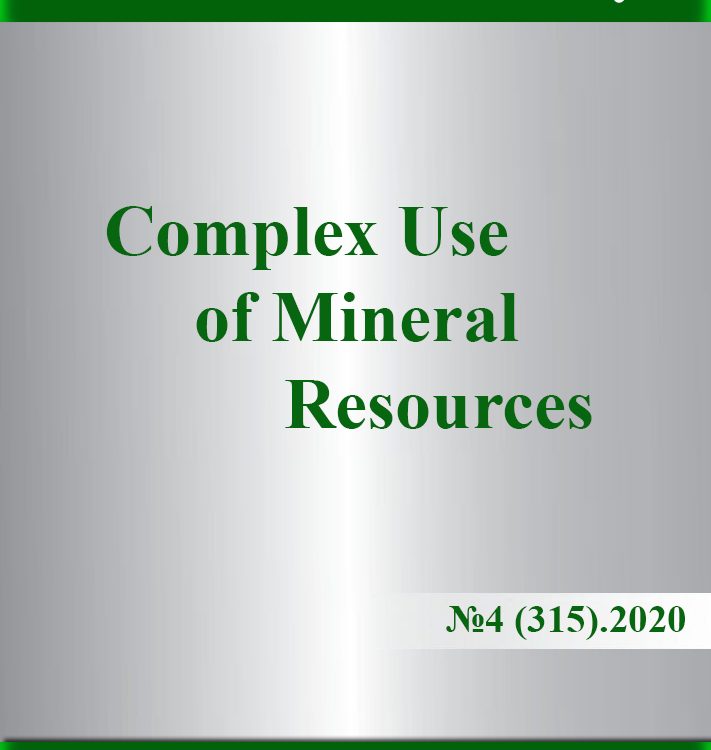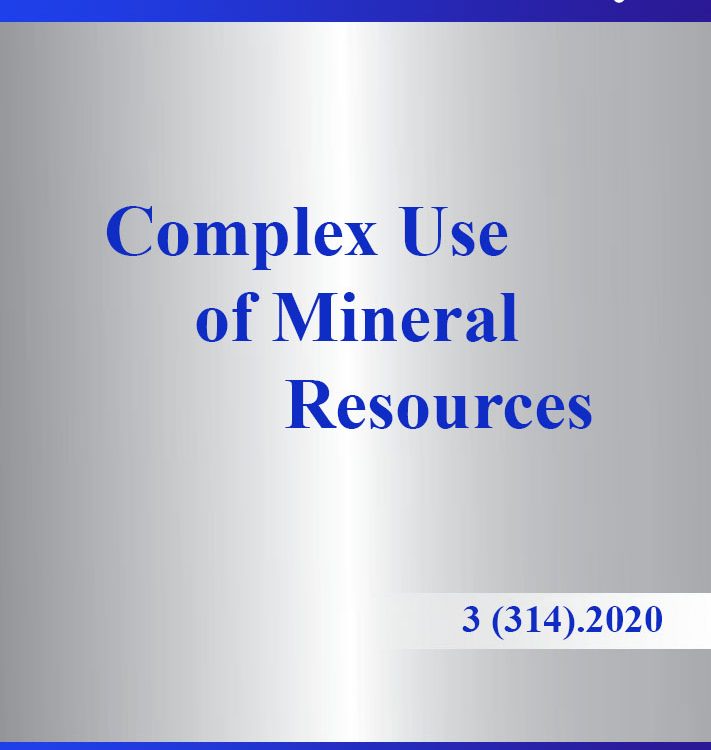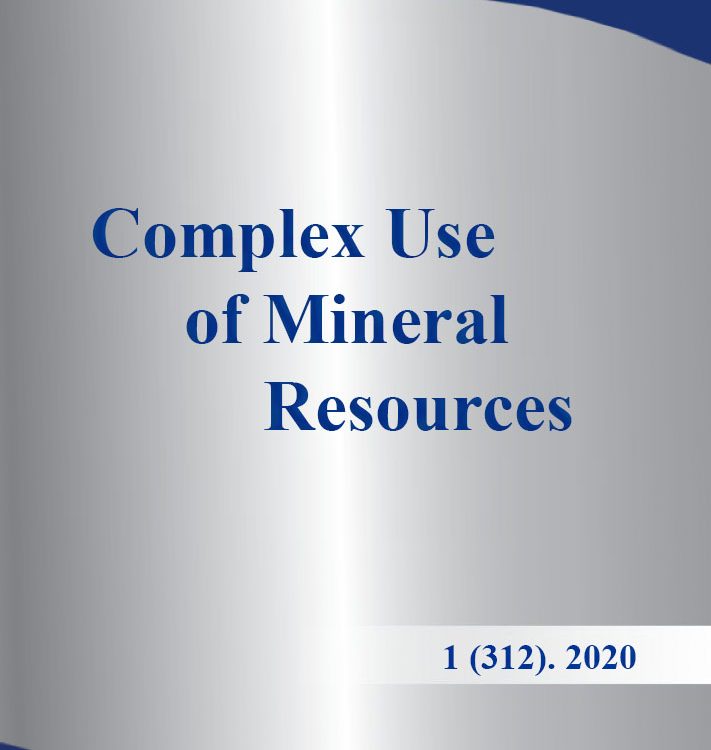Title: Technological experiments of joint smelting of lead intermediate products, recycled materials and high-sulfur copper-zinc concentrate
Authors: Dosmukhamedov N. K., Zholdasbay Е. Е., Kurmanseitov M.B., Argyn A.A. Zheldibay M. A.
Abstract: The purpose of this work is to improve the technological indicators of the existing mine contractile smelting technology by joint smelting of intermediate products, recycled materials of lead production with high-sulfur copper-zinc concentrate. It is established that during the smelting of copper-zinc concentrate which is difficult to process, high selective extraction of copper into matte and zinc into slag is achieved in one stage. The method consisted in the joint smelting of lead intermediates and high-sulfur copper-zinc concentrate in an electric furnace at a temperature of 1250 ° C under conditions of sequential blowing of the melt with air, then with natural gas. It is established that when the melt is purged with air and natural gas for 20 minutes, an equilibrium distribution of metals between the melting products is achieved. It is shown that simultaneous use of copper-zinc concentrate as a sulfidizer reduces the content of copper and lead in slag, increases the extraction of arsenic and antimony into the dust. Consumption of coke and quartz flux is reduced in comparison with the existing technology from 6.7 to 2.5% and from 12.5 to 2.8% of the initial feed weight, respectively, which significantly reduces material and energy costs of the process. As a result of extensive laboratory testing, the optimum composition of the new charge has been selected. Metal distribution between smelting products of the new charge with addition of 30% of high-sulfur copper-zinc concentrate was established. High recovery of copper to the matte up to 94.8%, against 83.7% according to the existing technology; lead to the rough lead - up to 93.6%, against 70.8%; zinc to the slag - up to 94.7%, against 83.7%; arsenic to the dust - up to 91%, against 69.5% and antimony to the dust - up to 92.3%, against 60.0% according to the existing technology.
Title: The effect of «pumping wells» procedure on the flow rate of extraction wells
Authors: Yusupov Kh. A., Omarbekov E.U.
Abstract: Study of application of «pumping wells» when mining of uranium deposits by in-situ leaching (ISL) to the mine "Karatau" under conditions of high pressure of groundwater character was performed. The operating «Karatau» mine is located in a deserted, inaccessible, sparsely populated area in the southwestern part of the Shu-Sarysuy depression in the territory of the Suzaksky district, Turkestan oblast. The «Karatau» deposit differs from other deposits in that self-pouring of geotechnological wells with a statistical level of +20 m is observed at all sites. The use of traditional technology for such deposit leads to excessive material and labor costs. Therefore, the technology of "pumping wells" is proposed. It is shown that the use of "pumping wells" procedure leads to achieving a uniform flow rate of extraction wells, reduction in the purchase of the cable production costs for the purchase of submersible pumps and wells in the end cap.
Title: Correlation in Disordered Systems
Authors: Shaikhova G. S., Adilbek N., Akhmetov K. М, Zhurov V. V., Shegebayeva G. E.
Abstract: In this paper, authors consider the theoretical aspects of the dynamics of liquid metals and the issues of correlations in disordered systems. The goal is to demonstrate that in choosing variables it is necessary to bring the equation of Markov processes to an approximation in which among the selected variables there are long-range components. However, this choice should include persistent variables. In numerous studies it is shown that selection cannot be made for the initial equation of motion with dynamic variables, and memory function analysis is required. As always, it contains a high-order memory function that can quickly decrease, and finally it can be again converted by the Markov process. Ways of simplifying the equation of Markov processes are given. In this work, authors derive the connection between the Fourier transform of the autocorrelation function and the imaginary part of the dynamic susceptibility and the result of the fluctuation-dissipation theorem.
Title: Cluster-associated viscosity model and methods for determining its parameters
Abstract: A detailed development of a hierarchical cluster-associate mathematical viscosity model is shown. The model is based on the equilibrium Boltzmann’s distribution and, therefore, is regarded as a chaosensitive property of a fluid inherent in it not only in motion but also at rest. In this model, the key characteristics are chaotic thermal barriers at the melting and boiling points, in connection with which the behavior of a liquid is determined by the action of three energy classes of particles – crystal-mobile, liquid-mobile, and vapor-mobile. An important single indicator in the new model depends on temperature and makes sense of the degree of association of clusters of crystal-mobile particles. The assignment of the activation energy of the viscous flow of melts determined by the Frenkel’s equation to the degree of cluster association gives a constant value commensurate with the binding energy of the van der Waals particle attractive forces. On this basis, the authors hypothesized that a viscous flow occurs due to the destruction of cluster associates while preserving the clusters themselves. To adapt the cluster-associate model to experimental data, certain data processing techniques have been developed to identify unknown model parameters. All calculations are illustrated on liquid lithium and have shown their high adequacy. Also added is a method for processing viscosity data using the entire set of viscosity data while maintaining two reference points and processing the rest to determine the degree of aggregation of associates.
Title: Activation of cement clinker with high content of belite
Abstract: The results of studies of cement clinkers with a high content of belite are presented. To obtain clinkers polymineral wastes of enrichment of skarn-magnetite ores were used. To intensify the hardening of cements, a method for activating the silicate phases of clinker (alite and belite) is proposed. Active phases are formed during the synthesis of clinker using a dual-blend technology, which provides an increase in the reactivity of the components of the raw material mixture. Thermodynamic calculations have been carried out, confirming the likelihood of belite formation reactions based on minerals of the raw material mixture. The composition of raw materials blends is justified. To assess the low-melting charge, a basicity coefficient (BC) was introduced and the preferred values of BC = 0.25 – 1.50 were shown. An increase in the activity of alite and stabilization of the active modification of belite provide hardening of the cement stone. The work is aimed at creating resource-saving technologies for Portland cement.
Title: Study of the possibility of molybdenum recovery from sulfate solutions on the anionite Lewatit MP62W5
Authors: Khabiyev A.T., Baigenzhenov O.S., Akbarov M.S., Sydykanov M.M
Abstract: This article presents the results of a study of sorption extraction of molybdenum from sulfate solutions obtained by leaching black-shale ores of Big Karatau. For the extraction of molybdenum was used the method of ion exchange weakly basic anion exchange resin Lewatit MP62W5. The study determined the optimal conditions for the sorption and desorption processes of molybdenum, which included factors such as pH, the duration of the process and the concentration of the necessary reagents. To study the optimal parameters of sorption extraction of molybdenum, the same anion-exchange resin Lewatit MP62W5 was used at a concentration of 0.073 g/l of molybdenum in initial solutions. Application of this anionite for 48 hours during the sorption process and increasing the pH to 5.5 leads to sorption of more than 88 % of the molybdenum from the solution. A solution of ammonium sulfate was used for desorption of molybdenum from saturated resins. It was found that the optimal duration of the molybdenum desorption process is 4 hours at a concentration of (NH4)2SO4 150 g/l. The degree of desorption in this case was 93-94 %
Title: Investigation of the anticorrosion properties of nano-СЕС in amine environments
Authors: Kemelzhanova A.,Mukasev K., Yar-Mukhamedova G., Lampke Th.
Abstract: It is known that of the methods for purifying gas fraction from hydrogen sulfide is amine treatment. Various types of amines are used to remove hydrogen sulphide, carbon dioxide and carbon dioxide from petroleum gases. The choice of specific amine depends on the needs of the process. Mono-ethanolamine (MEA) (C2H4OH) NH2 and diethanolamine (DEA) (C2H4OH) 2NH are commonly used. Both are ammonia derivatives. The develop recommendations on the choice of material from which to make equipment for amine plants, comparative studies of corrosion resistance of traditionally used low-temperature carbon steel and nano-composite coatings obtained by electrodeposition method. The research has shown, that average corrosion rate on a standard sample (without coatings) is 0.9969 mm/year. Because of this, the frequency of changing equipment for cleaning oil from acidic components (hydrogen, sulfide, carbon dioxide and carbon dioxide) on average is 1 time per two years. During the one year testing period nano-composition coatings showed protective efficacy when exposed to acidic corrosion/erosion. It should be noted that there is a likelihood of damage to the coating during mechanical action. It is established that the use of protective coatings leads to an increase in corrosion resistance 24-56 times, which indicates the expediency of their use in these operating conditions.
Title: Diversification of uranium production in order to extract associated precious metals
Abstract: Work aimed at diversification of production through the extraction associated with valuable metals in the uranium mines. The peculiarity of this work is the additional processing of spent and existing blocks using the existing production infrastructure for the extraction of associated useful components. Underground leaching technology is well developed for uranium deposits. The technology of underground leaching of associated components differs only in the reagents used, hardware design, etc., but they are fundamentally similar in the method of extraction. Even if there are associated components in the uranium-bearing Sands with a content of less than 1 g/t, up to 0.1 g/t production can be profitable. In this regard, the use of ready-made infrastructure of spent blocks in the uranium field allows us to expect good economic profitability in the future.
Title: Promising ways to increase raw material base of the chrome industry of the metallurgical industry of the Kazakhstan
Authors: Kuldeyev E.I., Bondarenko I.V., Temirova S.S.
Abstract: Various lumping technologies of finely dispersed chromite concentrates using charge roasting processes have been considered. In this respect, it was noted that the charge formulation used in the production does not provide the required strength of the produced pellets. The authors of the article propose the use of the well-known method for the ferrosilicon calcium fluxes (FSCF) synthesis with the replacement of Callovian clays with a composition based on diatomites and industrial and waste products of the Eurasian group (ERG) enterprises in order to increase the strength of pellets and agglomerate. This method enabled us to produce roasted pellets with high strength, to ensure the optimal ratio of components, to decrease the pellet roasting temperature by 150-200°C and to increase water resistance and congelation resistance. Technological parameters can be also improved by beneficiation of the source chromite raw material, effectively used by Turkish manufacturers of chrome products. One way to increase the chrome industry raw material base of the Republic of Kazakhstan is the involvement of the “12 Geophysical Deposit” into the processing of the industrial ore. However, the produced finely dispersed chromium concentrates require lumping followed by smelting in furnaces for ferrochrome. The high silica and iron content in the host rock of chromium concentrate enables to obtain strong pellets without additional additives.
Title: Obtaining of ferrosilicon from technogenic magnetite concentrate
Authors: Shevko V.M., Kaskin P. V., Badikova A.D., Amanov D.D.
Abstract: The article presents the results of studies on the production of ferrosilicon from iron ore (magnetite) concentrate and quartzite. The studies were carried out by thermodynamic simulation using the HSC-5.1 software package, based on the principle of Gibbs minimum energy and electric smelting of the concentrate together with coke and quartzite in a single-electrode arc furnace. Based on the studies, it was found that, under equilibrium conditions, the interaction of magnetite concentrate with silicon oxide (IV) and carbon is accompanied by the formation of FeSi (> 1200 0C), Fe3Si (> 1100 0C), FeSi2 (> 500 0C), Zng (> 800 0C) Pbg (> 1200 0C); the degree of silicon extraction into the ferroalloy depends on the ratio in the SiO2 / Fe3O4 mixture, decreasing from 85.6 to 66.1 (for example, at 17000С) with an increase in the SiO2 / Fe3O4 ratio from 0.42 to 1.25. When melting a mixture containing 70% concentrate, 11% quartzite, 19% coke, a ferroalloy containing 15-18% Si. The resulting ferroalloys are graded from FeSi15 to FeSi45.





